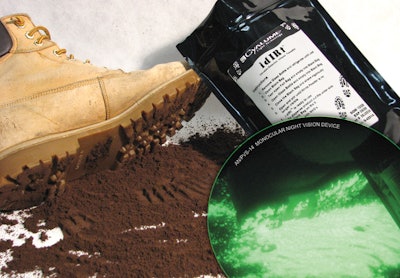 Photo: Cyalume Technologies.
Photo: Cyalume Technologies.
Wouldn't it be great if you could prove a suspect had been at the scene of a crime by following a pathway of telltale glowing light found on his clothing or vehicle after the fact? That's what Cyalume's idIRt can do.
Cyalume Technologies is best known for providing illuminating chem sticks to the military. By request, the company coated solid grains with the chemical formula to create a substance that looks like dirt to the naked eye but emits infrared light, which can only be viewed through night vision equipment. "The military uses it for covertly highlighting areas or identifying certain areas they want to come back and search, or for perimeter control," says Cyalume CEO Derek Dunaway.
But law enforcement agencies are interested in idIRt for a variety of applications that involve tracking criminals.
"The compound is unique. There's not anything out there in nature that normally generates infrared light," says Dunaway. "So if someone has this tracking on them or on their vehicle because they've gone through this, it's a very powerful forensic tool to be able to tie them to a place."
For example, idIRt can be used to catch burglars. If an agency has knowledge from an informant of an impending commercial burglary at a specific location, officers can set an invisible trap.
"It's easy for plainclothes officers to deploy this at access points to the building," says Jack Sullivan, a director of Cyalume's government products division. "And even if police couldn't contain all the suspects, if they broke out of the perimeter after a burglary in progress, the officers could see trace illumination in one way or another."
idIRt can also be used for trespass complaints, crime scene monitoring, investigating localized drug activity, and illegal border crossing.
As a former police officer with the New York State Police, Sullivan is excited by the prospects of idIRt's use in law enforcement. He likens the substance to a bank bag with an exploding paint device, because it marks robbers so they can be identified later. What makes idIRt so much better, though, is that the crooks don't know they've been marked so they won't even try to get rid of evidence or the infrared-emitting "dirt." It can create a virtual pathway from the crook's shoes, to his car, to his driveway, and inside his residence. And the effects are long-lasting.
"The slightest illumination even a month later could serve as corroborative evidence, if nothing else, placing the suspect at the point that this tool was deployed," Sullivan says. He encourages agencies using idIRt to let surrounding jurisdictions know to look for it and include it in search warrants related to crimes that could cross jurisdictional boundaries. Just like the criminals, if law enforcement officers don't know to look for idIRt, they won't find it and be able to use it as evidence.
Dunaway isn't worried that criminals will be able to detect idIRt to defeat it. "They'd really have to know what to look for and where to look for it, and get a night optical device. That's not standard issue for most of these criminals," he says.
idIRt is currently available in one-pound bags for under $35 in standard colors that look like dirt, sand, and even concrete for urban environments. Customized colors can be created for an additional cost. Before mixing its components to activate the illumination, a bag of idIRt can sit on the shelf for six months. "This is an extremely powerful, cost-effective tool," says Sullivan. "And the applications are only limited by your imagination."

